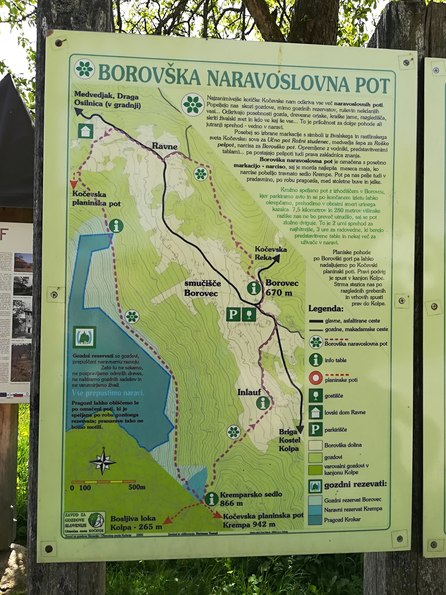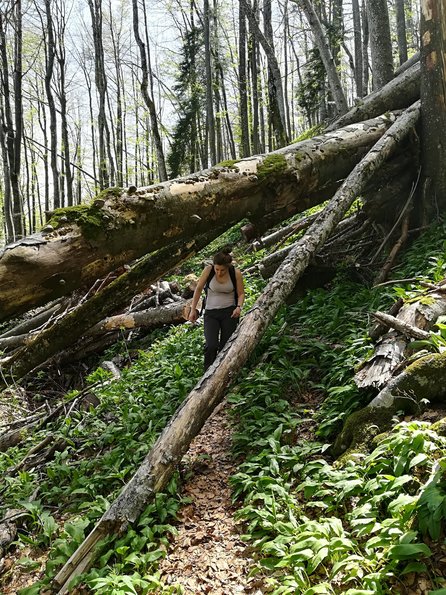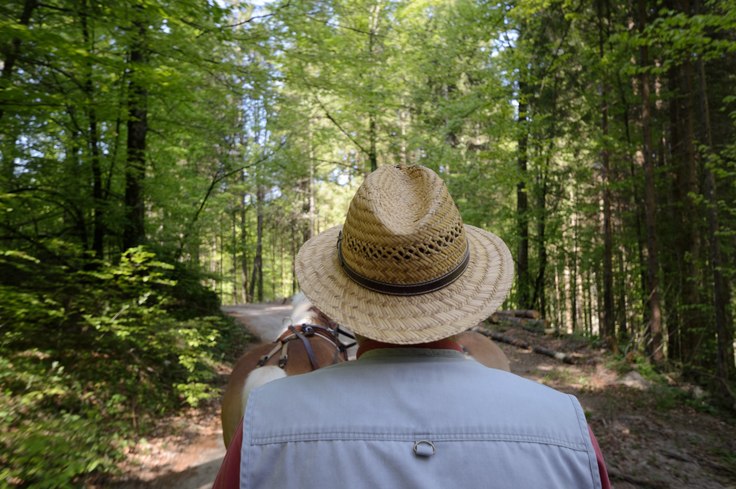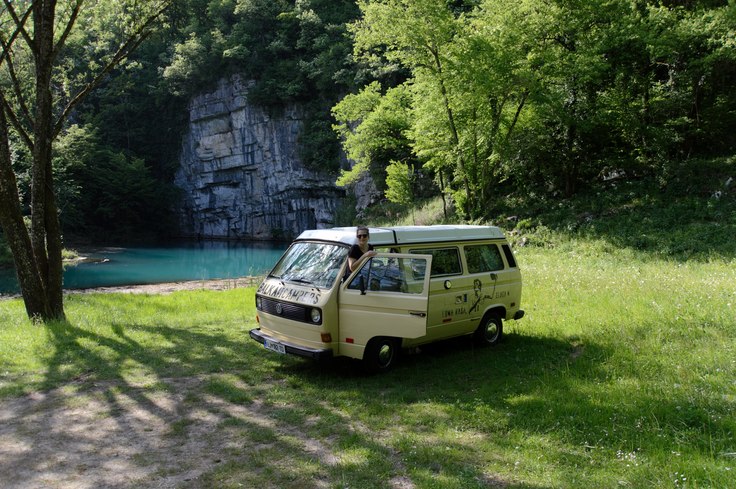5 days road trip - South-east Slovenia.
I've been following the story of Balkan campers since its very beginning and have even had the oppurtunity to drive the vintage vans here and there for fun, but time goes by and it has taken us till now to plan an actual vacation with one of the vans. It was a sunny friday and the forcast was fantastic for the next week. Žiga, a sunny soul with a friendly smile, parked the van in front of our house at around 3 pm. A short introduction to all the tricks and quirks of Krešo and we were off. Where to? This time we wanted to explore a region of Slovenia that we don't visit often - or in my case, haven't ever!
Camper van Krešo
First stop - Koèevje. The first association of any Slovenian with Koèevje is definitely bears. Sorry to say the two of us didn't see any, aside from a taxidermic one in a hunting lodge. Our two year old, on the other hand, spotted around five of them, while walking in the forest and from the van. So she says. Good eyesight of the younger camper I guess. We spent the night in Camp Jezero Koèevje. Very nice staff (staff meaning one employee and us being the only guests) and lots of info avaliable about hiking trails in the area. The region is well known for its virgin forests which we where interested in exploring. Virgin forests are forests in which man has not intervened and goings on in the forest follow only natural law. There are several in the region of Koèevje and they are home to bears, wolfs, wild cats and lynx. Since entry into these areas is prohibited, hiking trails follow their edges from where you can peek into these beautiful and ever more rare peices of nature.We decided on a trail on the edge of the virgin forest Krokar called Borovska path. The Krokar virgin forest containes mainly beech trees. A narrow path at the edge of the virgin forest is carved into a steep slope among centuries-old beech trees paved with neverending wild garlic growing at their feet. The path was slightly challenging with a two year old in a carrier backpack who of course wanted to walk by her self. We were a little bit scared of snakes and climbing over numerous fallen trees on the path was a little much. But all's well that ends well and we were a happy bunch when we came back to the van and had a little rest and snack.
 Borovška naravoslovna pot
Borovška naravoslovna pot
 kočevski pragozd
kočevski pragozd
From there we headed on to the village Koèe, which is named after wooden cottages and is one of the oldest settlements in the Koèevska Reka Valley. The first settlements of Slovenes date back to the 13th century, preceding the arrival of German colonists. By 1880, most people in Koče were of German origin, but left during the 2nd world war, when Italians occupied the area. After world war II, in the time of communist Yugoslavia, underground facilities where built for military reasons and the area of Koèevska Reka was closed off and inaccessible for people outside the area. In Koče, We were lucky to make aquantance with a kind mister who took us on a very pleasant drive through the surrounding woods in a horse-drawn carriage and told us stories of forest picnicks and bear encounters on the way!
 coachman and horses
coachman and horses
Next stop was Kolpa river valley. The Kolpa river forms the border between Slovenia and Croatia. We took a lovely local road winding alongside the river to a small village called Dol, where we stopped at camp Konda. This is a lovely small campsite right next to the river owned by locals who also produce ecologic dairy products from sheep. Delicious yogurt and cheese for dinner and breakfast, a canoe ride on the river and lots of relaxing (or as much relaxing as is possible with a hyperactive two year old).
 Camper van Krešo in campsite Konda
Camper van Krešo in campsite Konda
Kolpa river dam
Our next destination was the Krupa river spring - probably one of the most beautiful sites in Slovenia and a real hidden wonder. We where completely alone for most of mid-morning, so we marveled at the surroundings, kicked a ball around for a bit and made some pasta for lunch. This is one of the beauties of traveling with a camper van. Wherever or whenever you decide to stop, you have a teeny tiny apartment with you - a bed, a couch, a dinning room and a kitchen. May this be a store parking lot or the Krupa river spring. very handy, especially with a kid along! After lunch with a view we made a short hike through forests and pastures to a small Palaeolithic carst cave. My first urge to explore the cave was immediately hampered by a second inkling not to, since I was obviously still under the influence of bear territory (probaly not justified) and the cave seemed like a cosy choice for a bear's dwelling. Just so you know, I was the only sissy and the rest of the party entered and exited the cave unharmed.
 Kreso camper van and Krupa river spring
Kreso camper van and Krupa river spring
From there we drove to Otočec, best known for its beautiful gothic castle built in the middle of shallow running waters of the river Krka. We didn't however pay all that much attention to the castle since we where so happy with the camp a few hundred meters on. The only other camp guests where an elderly German couple. We set up camp right next to the river and admired swans, ducks and other unidentified flying creatures untill sundown. The Dolenjska region has been called the Slovene Tuscany and is known for its green meadows, fertile vineyards and underground hot springs. This was our next and last destination, a natural spring called the Klevevž spring. Water from a thermal spring is collected in a small stone pool and has a temperature between 20 and 25 degrees celsius all year round. The ladies taking a dip there where convinced of its powerful healing abilities. So are we, since vacation has powerful healing abilities and we where there on vacation. Viva la vacation! we shreiked as we jumped into the powerful healing waters. Later that day, rain drove us home, where we where oh so happy to be reunited with our washing machine and our big comfy bed. Till next time Krešo!
 Baby behind the steering wheels
Baby behind the steering wheels